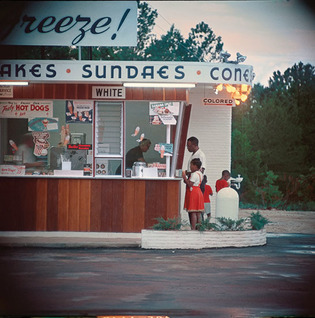
Gordon Parks
The untitled photo is one of more than 200 original color transparencies rediscovered by the Gordon Parks Foundation in 2014. In 1956, photographer Gordon Parks spent two weeks following the Thornton family of Alabama with his camera for Life magazine; Life published 26 of the images. The Parks Foundation published all of the photos in the book Segregation Story.
View full image
This photograph by Gordon Parks, captured in Shady Grove, Alabama, in 1956, depicts an instantly familiar summer ritual: members of the Thornton family going out for ice cream. The twilit outdoor stand looms in three quarters of the frame, a clamor of advertisements against the deserted foreground. Amid the muted greens, browns, and blues of the color transparency film, three children in vibrant red T-shirts and pinafore already enjoy their cones as their father pays. Above their heads, another pop of red, an arrow, underlines the word “COLORED,” transforming the scene’s apparent Rockwellian nostalgia for its true subject: racial segregation, in full color.
Parks’s photograph captures the everyday indignities of the Jim Crow era, whose outright violence and terror he also covered and experienced firsthand on his trip to Alabama. He followed the Thornton family for two weeks for Life magazine, whose editors expected their audience to be unfamiliar with the lived experience of Jim Crow, still prevalent in the aftermath of the Supreme Court’s Brown v. Board of Education rulings. The resulting feature, appearing a few years after Life first began to publish photo essays in color, would be titled “The Restraints: Open and Hidden.”
While 26 images were published in the Life feature, more than 200 original color transparencies, including this image, were rediscovered by the Gordon Parks Foundation in 2011 and subsequently exhibited and published in a book as Segregation Story. The photographs from this series are described using words like “quiet,” “dignified,” “serene,” and “understated.” The ironies and outright hypocrisies of anti-Black racism had been called out more directly in Parks’s earlier, more controversial, and most well-known photograph, American Gothic, in which custodial worker Ella Watson stoically holds her broom before a gigantic American flag. By contrast, in this photograph, Parks exchanges the overt irony of the portrait of Watson for a gut punch, perhaps inspired by the words of Richard Wright, who described aspects of the segregation regime as “[not] brutally cruel, but subtly cruel.”
The Beinecke Library recently acquired a print of this photograph and others from Segregation Story for the James Weldon Johnson Memorial Collection, as well as ten other study sets from among Parks’s most celebrated projects. The sets, selected in collaboration with the Gordon Parks Foundation, span his career as a documentary photographer and photojournalist, from images captured for the Farm Security Administration in Washington, DC, in 1942 through his tenure at Life, where he became the magazine’s first Black staff photographer in 1948.
 loading
loading